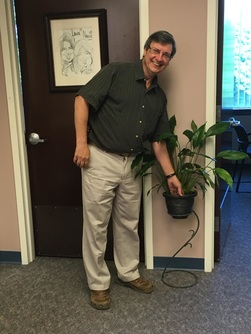 Dan checking to be sure our work environment isn't hazardous. Dan checking to be sure our work environment isn't hazardous. It was a pleasure to hear Dan White, Mountain Laurel Environmental, speak today about his, and Shelton's, history. From the beginning it was hard to differentiate between the two for as he said, the history of Shelton is also his history. Shelton started off as a small farming community that quickly went through industrialization as families moved in from Europe for factory jobs. White's grandparents were two of the many who migrated to Shelton to work in the factories. White recalls living in a two family house growing up, on 1/8th of an acre, with no air conditioning, no heat and no insolation. There was no need to drive anywhere, for he attended the neighborhood school, frequented the library, and could even walk to his first job by the factories where his grandparents worked. He laughed recalling his first job- working in 100 degrees heat; "I learned what I didn't want to do for the rest of my life." Growing up, besides the awe of being able to live so closely to rural farms and the downtown city area, White was constantly exposed to pollution. In 1970 he skipped school to take part in Earth day, raising awareness of the water pollutions, smog issues and pesticide dangers. He explained that the rivers would changing colors based on the factory waste and that smog often filled the air of his town. Shelton was becoming overcrowded as people continued to move in. The schools were trying to fit 3 children to a locker! And with all this influx of population came an influx of waste. Finally came the Arson of 1975, what White describes at the climax and ultimate reaction to all that Shelton was facing. Perhaps it was through witnessing all this that he felt inspired to join the hazardous waste clean-up efforts. He explained his passion is not only in protecting people from these dangerous areas but in restoring what these polluted lands used to be. And it's surely no small task. The investigation alone is costly for it demands sample taking. This, depending on where, can call for drilling up to 300 feet into the ground. Then comes testing each sample which again costs time and money. White explains you need to know what you're looking for. There's no magic machine you can put the samples in that will then tell you what exactly you're looking at; you have to test for one thing at a time. Finally, in terms of clean-up, while the means to do so seem endless, it's important to choose the right strategy for each specific situation. That can mean anything from removing all the contaminated soil, isolating the pollution, injecting oxygen compounds that will breakdown the harmful pollutants, insertion of barriers, or even ongoing and continuous monitoring. Each step of hazardous environment clean-up require time, money and the attentive skillful effort of the experts in charge. For outsiders, it's sure to look like a daunting task, but for Dan White, he couldn't see himself doing anything else. "Have you ever heard 'your career doesn't define you'?" White asked in opening his presentation, "I don't believe that." For Dan White, his career, his town's history, and his own experiences have helped shape who he is today, and for those of us who don't quite have the patience nor skill to clean up the environment for ourselves, we're surely grateful for that! -Amanda Stockla, 2016 GVCC Intern |
CategoriesAuthorsGreater Valley Chamber Staff, Interns & Members Archives
November 2023
|

 RSS Feed
RSS Feed
